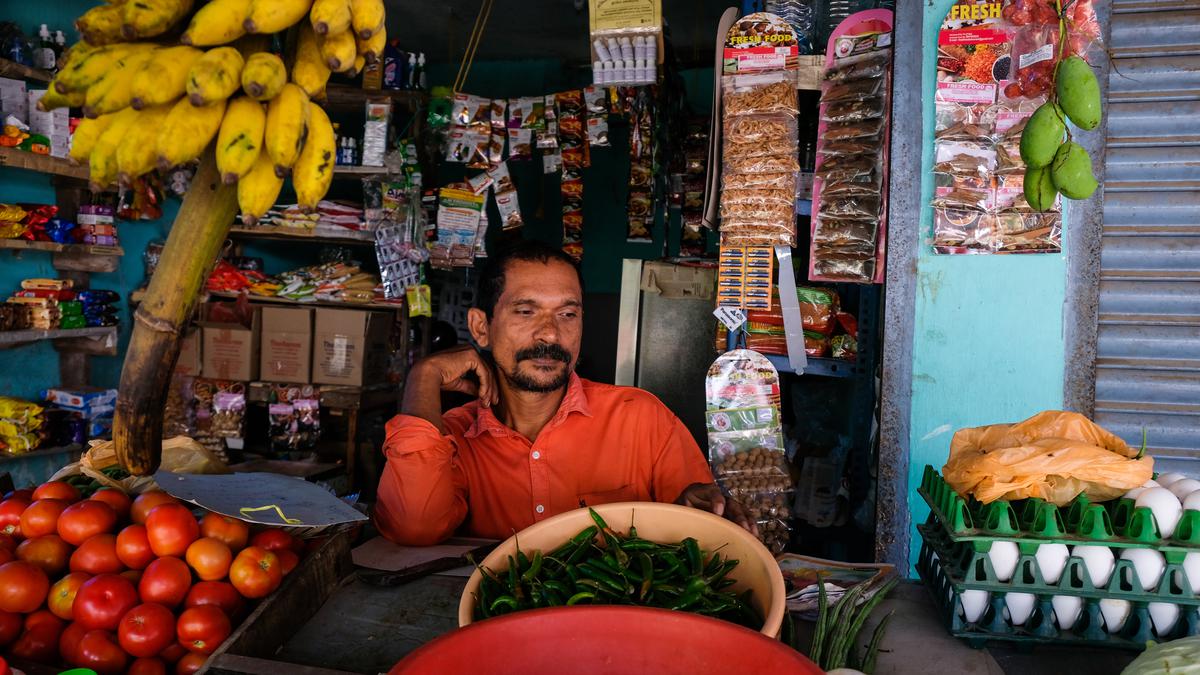
They swim against the current of climate change Premium
The Hindu
But Man is Not Made for Defeat, being exhibited at Chitrakala Parishath, captures multiple ways in which people adapt to climate change, with all its complex socio-political ramifications.
A heap of tomatoes gleams in the light as do the tub of chillis beside it, while the shop’s proprietor, wearing a shirt that nearly matches the colour of the tomatoes, looks sagely on. It feels like an idyllic scene out of small-town India, a pictorial representation of a ubiquitous kirana store, the mainstay of local inhabitants. And yet, the story behind the photograph, one of the many currently being exhibited at Chitrakala Parishat, is so much more.
“That picture is of a man whose farming had failed,” points out documentary photographer and filmmaker, Arjun Swaminathan, who has captured this image. “His natural adaptation to this was to keep a grocery store,” adds Mr. Swaminathan, the director of Native Picture, an organisation that focuses on documenting the lives and issues faced by common people.
This man is one among many in Kozhikode, Kerala, who has been directly impacted by climate change, and found ways to modify his existence in response to it, without external intervention. “It is called autonomous adaptation to climate change,” points out Kalaiarasi Ka Sa, a project associate at the National Institute of Advanced Studies (NIAS), Bengaluru, which is spearheading this photo exhibition titled But Man is not made for defeat, a title derived from a line in Ernest Hemingway’s 1951 allegorical novella, The Old Man and the Sea.
Staying true to the central theme of Hemingway’s novella, this nuanced, powerful photo essay is a testament to people’s struggle and triumph over nature. Part of a larger study under the inequality and Human Development programme by NIAS, headed by Professor Narendar Pani, the exhibition looks at “climate change as a process,” points out Ms. Kalaiarasi. “We thought we would look into the adverse effects as well as the growth opportunities,” she says.
“The discourse around climate change always focuses on extreme events. Only when something hits, we will think about it,” points out Nisar Kannangara, a postdoctoral associate at the Inequality and Human Development Programme. There are actually two effects of climate change -- extreme events, yes, but also long-term events, he points out. “In the last three decades, there have been minor changes in temperature. The effect of that on people hasn’t been reflected in research so far,” he says.
This study, conducted by Mr. Kannangara and Ms. Kalaiarasi, and supported by TCS, explored the more long-term effects of climate change. By looking at the meteorological data of various Indian districts, collected over decades, the researchers discovered that Cachar in Assam and Kozhikode in Kerala were the two places most exposed to multiple climatic events, both long-term trends in key parameters like temperature and precipitation and associated events like floods, heatwave, and droughts. They looked into just exposure while mapping, says Ms. Kalaiarasi, “We then tried to integrate trends in complex phenomena like extreme rainfall events and cyclones.”
Kozhikode was finally chosen for fieldwork because of the complexity of its terrain. “It had different terrains which Assam did not have,” points out Mr. Kannangara. Three places were chosen for this, extensive ethnographic research study -- a coastal village, a midland village, and a hilly area-- and he spent around six-odd months overall in these villages, talking and building a rapport with local inhabitants. “When I asked people in the coastal village about climate change, they told me no one was experiencing it,” recalls Mr. Kannangara. “They told me that I had to go to Thiruvananthapuram or Thalassery for that.”













